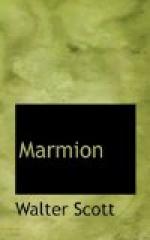Stanza xv. lines 415-20. Cp. description of Sir H. Osbaldistone, ‘Rob Roy,’ chap. vi.
line 429. ’The ruins of Tantallon Castle occupy a high rock projecting into the German Ocean, about two miles east of North Berwick. The building is not seen till a close approach, as there is rising ground betwixt it and the land. The circuit is of large extent, fenced upon three sides by the precipice which overhangs the sea, and on the fourth by a double ditch and very strong outworks. Tantallon was a principal castle of the Douglas family, and when the Earl of Angus was banished, in 1527, it continued to hold out against James V. The King went in person against it, and for its reduction, borrowed from the Castle of Dunbar, then belonging to the Duke of Albany, two great cannons, whose names, as Pitscottie informs us with laudable minuteness, were “Thrawn mouth’d Meg and her Marrow”; also, “two great botcards, and two moyan, two double falcons, and four quarter falcons”; for the safe guiding and re-delivery of which, three lords were laid in pawn at Dunbar. Yet, notwithstanding all this apparatus, James was forced to raise the siege, and only afterwards obtained possession of Tantallon by treaty with the governor, Simon Panango, When the Earl of Angus returned from banishment, upon the death of James, he again obtained possession of Tantallon, and it actually afforded refuge to an English ambassador, under circumstances similar to those described in the text. This was no other than the celebrated Sir Ralph Sadler, who resided there for some time under Angus’s protection, after the failure of his negotiation for matching the infant Mary with Edward vi. He says, that though this place was poorly furnished, it was of such strength as might warrant him against the malice of his enemies, and that he now thought himself out of danger. (His State papers were published in 1810, with certain notes by Scott.)
’There is a military tradition, that the old Scottish March was meant to express the words,
“Ding down Tantallon,
Mak a brig to
the Bass.”
’Tantallon was at length “dung down” and ruined by the Covenanters; its lord, the Marquis of Douglas, being a favourer of the royal cause. The castle and barony were sold in the beginning of the eighteenth century to President Dalrymple of North Berwick, by the then Marquis of Douglas.’—Scott.
In 1888, under the direction of Mr. Walter Dalrymple, son of the proprietor, certain closed staircases in the ruins were opened, and various excavations were made, with the purpose of discovering as fully as possible what the original character of the structure had been. These operations have added greatly to the interest of the ruin, which both by position and aspect is one of the most imposing in the country.
line 432. ’A very ancient sword, in possession of Lord Douglas, bears, among a great deal of flourishing, two hands pointing to a heart which is placed betwixt them, and the date 1329, being the year in which Bruce charged the Good Lord Douglas to carry his heart to the Holy Land. The following lines (the first couplet of which is quoted by Godscroft, as a popular saying in his time) are inscribed around the emblem:—




